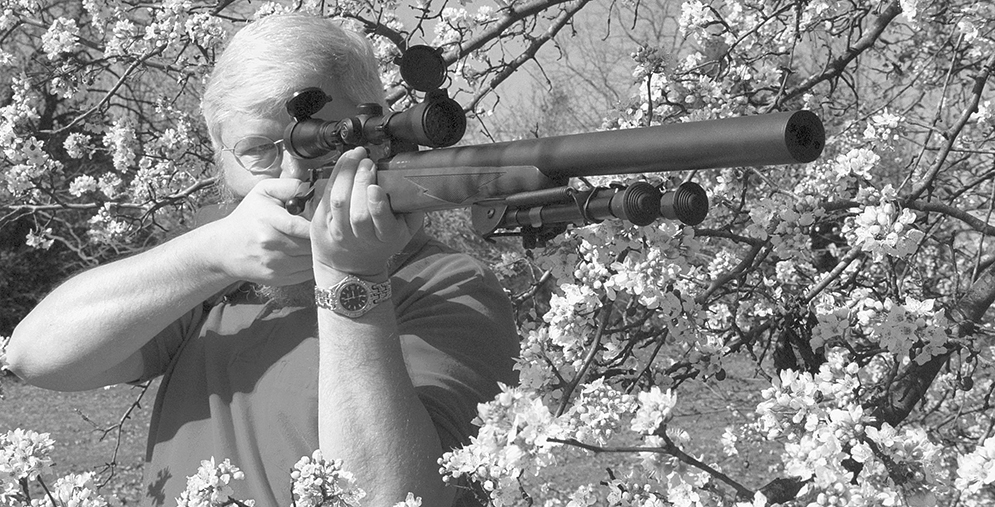The Model MCC suppressed carbine from John’s Guns provides a compelling mix of performance characteristics. P.H. Walter photo.
By Al Paulson
While some silencer owners view sound suppressors as recreational investments, other end-users view silencers as tools for solving problems. The silenced .22 rimfire rifle or pistol is the most popular instrument for both groups, being well suited for such diverse applications as discreet target shooting, stealthy pest control, and the surreptitious destruction of objects (such as taking out a yard light or flattening the tire of a potential getaway vehicle) prior to a law-enforcement raid. When it comes to the stealthy elimination of animals larger than a small dog, however, the .22 rimfire will not deliver adequate terminal ballistics unless the central nervous system (CNS) is hit. Even suppressed .30 caliber rifles deliver poor terminal ballistics when bullets of conventional design are driven at subsonic velocity, unless a CNS shot is taken. That’s because so-called stopping power is best predicted by the size of the permanent wound channel (unless nonelastic tissue like brain or liver is hit). Given adequate penetration, a subsonic bullet of .44 or .45 caliber will cut and crush more tissue, leave a larger permanent wound channel, and generate more rapid blood loss than a subsonic bullet of .22 or .30 caliber. Whether the end-user is a rural homeowner, farmer, rancher, small-town or rural law-enforcement officer tasked with occasional animal control duties, or a full-time animal-control professional, a suppressed carbine of .44 or .45 caliber represents particularly practical and useful technology when it comes to putting down animals as large as deer.
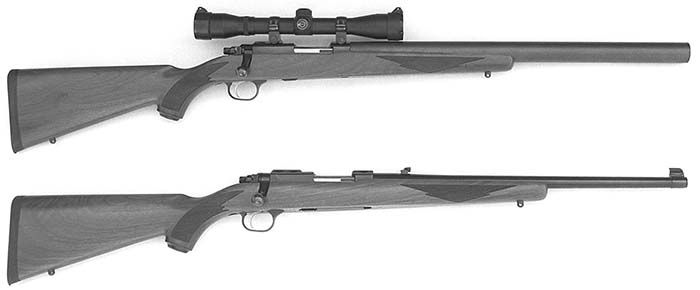
Regrettably, no such weapon has been available commercially until quite recently. The reason was not the lack of appropriate silencer technology, but rather the lack of an appropriate rifle of .44 or .45 caliber.
Admittedly, a practical silenced .45 caliber weapon was developed by the British for commando operations during World War II. Called the De Lisle Silent Carbine, this .45 ACP weapon continued to deliver excellent service in an anti-personnel role during counter-insurgency operations and counter-terrorist missions for several decades following World War II. It was never offered commercially, however. When Marlin introduced the .45 ACP Camp Carbine in 1986, I thought we finally had a suitable platform for a silenced carbine of major pistol caliber. I purchased one of the first Camp Carbines to reach the marketplace and fitted it with an integral silencer. In fact, this was the first sound suppressor I actually built myself. It was very quiet and delivered excellent performance on the packs of feral dogs plaguing our area. Unfortunately, the Camp Carbine was neither robust nor well made. The barrels were of mediocre quality, and the small parts that made up the bolt hold-open device were a constant source of trouble until I finally discarded them entirely. Worst of all, when fired with hot or heavy loads, the carbine’s hammer tended to rotate rearward past contact with the trigger sear, jamming in this rearward position. Pulling the trigger would then have no effect on the hammer, so this malfunction placed the gun out of service until the gun was disassembled and the trigger group was removed. The hammer was then pulled forward until it engaged the trigger sear again, and the gun was reassembled. Despite these frustrations, the Camp Carbine remained the only game in town for the next eleven years, when it came to adding a silencer to a currently produced carbine of major pistol caliber.
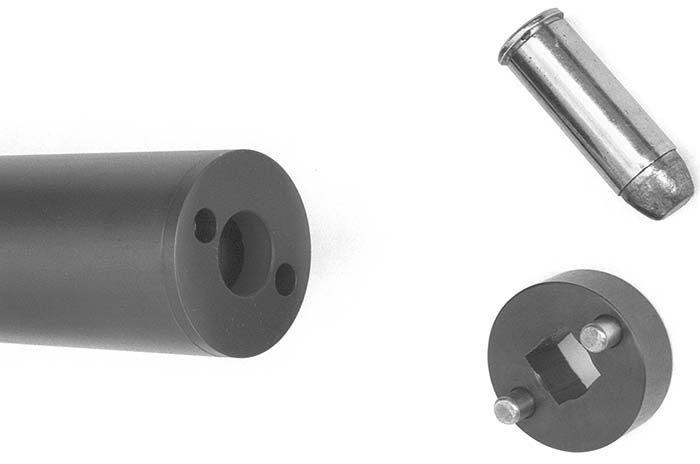
The introduction of the .44 Magnum Ruger 77/44 carbine in 1997 finally provided a robust rifle of suitable caliber for both silencing and delivering reliable kills of animals up to the size of deer. Parenthetically, production of the Marlin Camp Carbine ceased two years later. The Ruger provides an ideal base weapon for silencing because the 77/44 works well with .44 Special ammunition, which is subsonic and therefore does not produce a loud ballistic crack. Furthermore, the .44 Special has an excellent track record on deer, feral dogs, and feral hogs. Finally, the design and location of the magazine are compatible with the addition of an integral sound suppressor
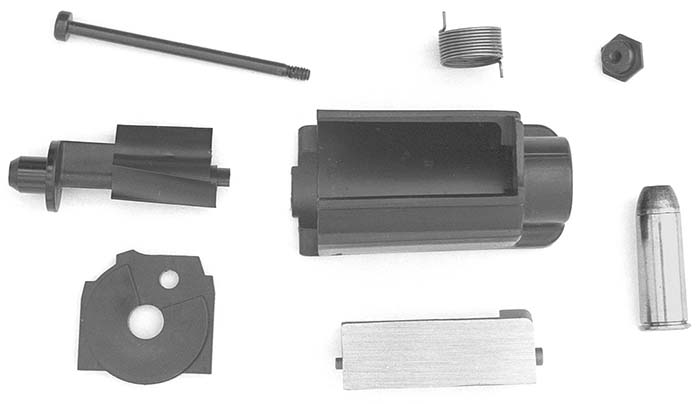
John Tibbetts of John’s Guns was one of the first to silence the Ruger 77/44 rifle after its introduction. His Model MCC suppressor is still one of the best. This system features an integral suppressor tube that is 20 inches (50.8 cm) long and just 1.25 inches (3.2 cm) in diameter, producing a suppressed carbine with an overall length of 40.6 inches (103.1 cm). Barrel length is reduced to 16.5 inches (41.9 cm), and the short barrel is stretched under considerable tension to minimize barrel harmonics. The barrel is ported to vent high-pressure combustion gases into the rear of the integral sound suppressor. System weight as shown in the accompanying photograph with an unloaded magazine and a Simmons 4x .22 MAG Scope was 8.1 pounds (3.7 kg). The relatively small diameter of the suppressor enables Tibbetts to inlet the stock for the silencer, and still leave enough wood for using a bipod attached to the forward sling stud. The quality of the inletting for the suppressor is superb, which tends to inspire confidence in the workmanship that remains hidden from view.
The handsomely proportioned suppressor not only looks good on the little 77/44 action, it performs well. When this system was evaluated at the 1999 National Silencer Trials sponsored by The Small Arms Review, the suppressed 77/44 delivered one-hole groups at close range with Black Hills 210 grain .44 Special ammunition (Black Hills Ammunition, Inc., Dept. SAR, P.O. Box 3090, Rapid City, SD 57709-3090; phone 605-348-5150; fax 605-348-9827; URL http://www.black-hills.com). Furthermore, this system was quieter with Black Hills .44 Special ammunition than a number mainstream suppressed submachine guns when fired with Black Hills 9x19mm subsonic ammo. A number of industry insiders attending the Silencer Trials placed orders on the spot. That’s quite a testimony to the performance and workmanship of this system.
My own independent testing used a variety of factory .44 Special ammunition plus a real thumper of a handload developed by Tom Denall of T.D. Manufacturing for maximum penetration in large game. Denall’s load features a 300 grain lead flat nose (LFN) bullet in front of 7.5 grains of Unique. This load uses .44 Magnum brass to place the projectile as close as possible to the onset of rifling. This round provides a nominal velocity of 950-969 fps at an altitude of 3,500 feet, providing optimum velocity and maximum penetration for a subsonic round of this caliber. My testing also included the following .44 Special factory ammo: Winchester 240 grain LFN, Winchester 246 grain LRN, and Black Hills 210 grain LFN. The Black Hills round has generally been the most accurate .44 Special round in the Ruger 77/44 in my experience, probably in part because its relatively lightweight projectile works better at subsonic velocity in the Ruger’s 1 in 20 inch rifling twist rate.
Performance
I tested the performance of the suppressed and unsuppressed carbines using the specific equipment and testing protocol advocated at the end of Chapter 5 in the book Silencer History and Performance, Volume 1 (Wideworld, Dept. SAR, P.O. Box 2560, Conway, AR 72033; $50 plus $5 s&h, check or MO). Testing was conducted at an atmospheric temperature of 54°F. Ammunition was kept at ambient temperature in a cooler in the shade until needed. Unsuppressed sound pressure levels (SPLs) were measured 1 meter to the left of the muzzle using a Brüel and Kjaer Type 2209 Impulse Precision Sound Pressure Meter (set on A weighting and peak hold) with a B&K Type 4136 1/4-inch condenser microphone, while suppressed levels were measured 1 meter to the left of the suppressor. Velocities were measured in feet per second using a P.A.C.T. MKIV timer/chronograph with MKV skyscreens set 24.0 inches apart and the start screen 8.0 feet from the muzzle (P.A.C.T., Dept. SAR, P.O. Box 531525, Grand Prairie, TX 75053, 214-641-0049). At least 10 rounds were fired to obtain an average sound signature or muzzle velocity. The suppressed and unsuppressed sound signatures, as well as the net sound reductions, appear in Table 1. Velocity and accuracy data are in Table 2.
Subjectively, the Model MCC suppressed carbine proved a delight to shoot thanks to its light weight and modest size. It’s a lot handier than a De Lisle Silent Carbine. While the Model MCC suppressor does reduce felt recoil, the shooter still experiences a noticeable push, especially with heavier bullets. A law-enforcement officer watching me shoot the suppressed 77/44 asked if he could try it. Seduced by the very soft sound signature into expecting the recoil of a pellet gun, he did not properly seat the buttstock into his shoulder. The officer touched off one of Tom Denall’s 300 grain handloads. The stock accelerated rearward and slammed into his shoulder. A man of few words, his eyes got wide and a big grin slowly spread across his face, as if to say “this is a real gun, even if it doesn’t sound like one.” After that, he seated the buttstock properly into the pocket of his shoulder and found that felt recoil was both manageable and comfortable when shooting quick action drills or shooting prone with a Harris bipod.
Objectively, three performance criteria are important when evaluating the silenced Ruger 77/44: accuracy, projectile velocity, and sound reduction.
In terms of accuracy, unmodified Ruger 77/44 carbines typically deliver 2-3 MOA groups with factory ammunition in my experience. The accuracy data in Table 2 show that the lightweight projectile used in the Black Hills round delivered the same group size in both the suppressed and unsuppressed carbine. When using ammo with bullets of conventional weight for factory .44 Special ammo, suppressed group size averaged just 52-67 percent of unsuppressed group size. Thus, the suppressed carbine is significantly more accurate than the unsuppressed carbine when using conventional .44 Special ammunition. That’s gratifying performance. The big surprise came when using the powerful 300 grain Denall handloads. Suppressed group size averaged just 79 percent of the unsuppressed group size, despite the fact that the barrel’s rate of twist is optimized for much lighter bullets traveling at much greater velocity. That’s good news for anyone requiring maximum penetration in large animals.
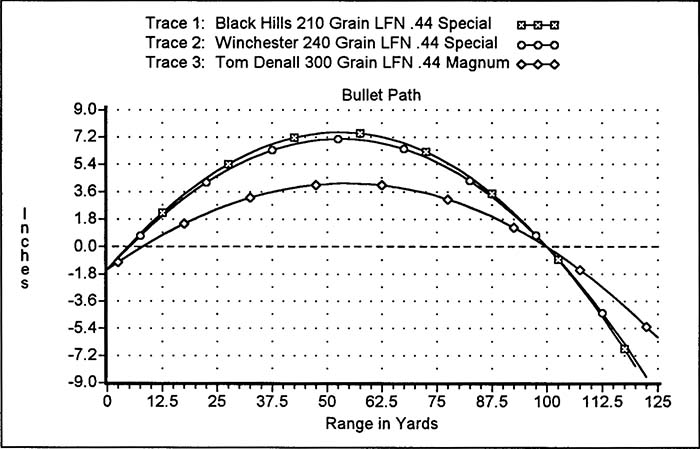
In terms of velocity, the ported barrel of the suppressed 77/44 drops projectile velocity by 9-10 percent with factory ammo and by just 4 percent using the 300 grain Denall load. In fact, velocity with the Denall load is virtually perfect when it comes to optimizing subsonic projectile velocity for use in a silenced firearm. My own experience suggests that maximum practicable projectile velocity for subsonic ammunition is 1,000 fps. This velocity should give maximum penetration that can be achieved without the risk of objectionable bullet flight noise over a wide range of temperatures. Using factory ammunition, the relatively modest velocity loss produced by the Model MCC suppressor compares favorably to other integrally suppressed carbines, which may drop projectile velocity by 20-30 percent to achieve good sound suppression. Anyone using the Model MCC carbine on live targets will be grateful that John Tibbetts did not employ more aggressive barrel porting.

Since these tests involve such diverse bullet weights, it would be useful to compare the external ballistics of the 210 grain, 240 grain and 300 grain LFN loads used in this study. Figure 1 compares bullet velocities. Figure 2 compares bullet paths (trajectories). Figure 3 compares bullet momentums, which will correlate in some fashion with penetration. Figure 4 compares bullet drop. Clearly, a working knowledge of a particular round’s trajectory and the ability to accurately estimate (or measure) range will be important for precise shot placement throughout the effective range of the cartridge.
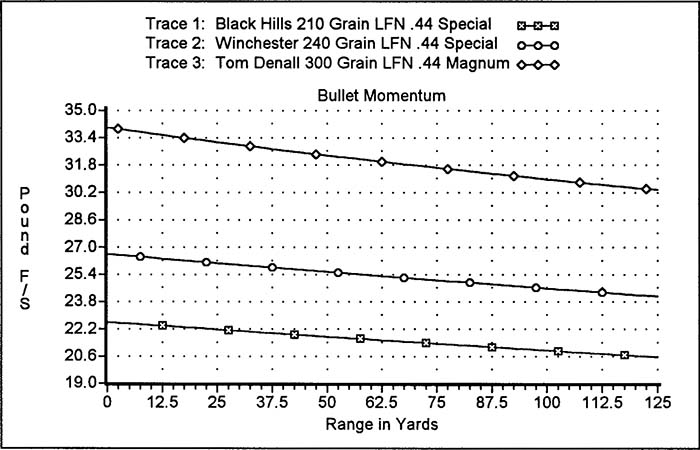
In terms of sound suppression, the Model MCC silenced Ruger 77/44 produced peak sound pressure levels (SPLs) varying from 128-130 decibels using factory ammunition. When using Black Hills fodder, the suppressed 77/44 sounded almost as quiet as an HK MP5SD. That’s impressive performance, especially when considering the large bore and the relatively small diameter of the suppressor. Even using the powerful 300 grain Denall load, the suppressed Ruger’s SPL was just 133 decibels, which sounded very much a suppressed Uzi I recently fired with IMI 158 grain 9x19mm subsonic ammunition. Yet the suppressed 77/44 delivered a 300 grain projectile with 136 percent of the frontal area and 190 percent of the weight of the 9mm projectile, which left the Uzi at comparable velocity to the 300 grain pill from the suppressed Ruger. Guess which round would produce a larger permanent wound channel.

Conclusions
The Model MCC suppressed carbine from John’s Guns provides a compelling mix of performance characteristics. It’s light, handy, and handsome. It delivers significantly better accuracy than an unmodified Ruger 77/44 carbine with most ammunition. It is quiet enough for stealthy shooting in an urban environment. And it provides appropriate terminal ballistics for animals up to the size of deer. This suppressed 77/44 is well suited for solving a diverse array of four-legged problems. Whether that problem is quietly eliminating troublesome deer inside an airport fence, putting down a feral dog nipping at a valuable horse, or killing feral hogs destroying a bean field, the Model MCC suppressed Ruger 77/44 is an accurate and stealthy tool that I can recommend with enthusiasm.
For more information, contact John’s Guns, Dept. SAR, 3010A Hwy. 155 N., Palestine, TX 75801; phone 903-729-8251; fax 903-723-4653.
| This article first appeared in Small Arms Review V4N7 (April 2001) |



